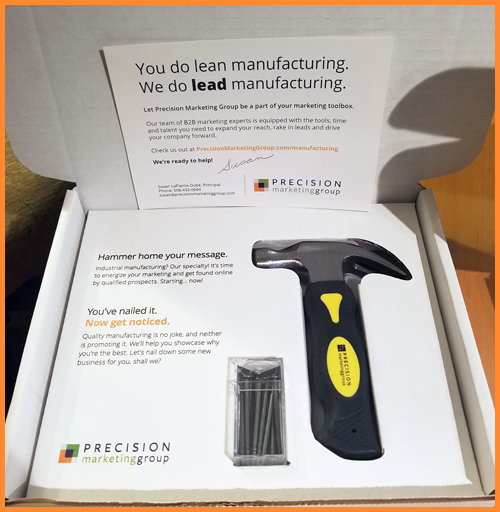Much of marketing is about laying a strong foundation for sales, bringing qualified leads to the door, and staying connected and top of mind with your existing customers.
However, some audiences often get neglected when developing a company's marketing plan: past/inactive prospects and clients.
We have found that these buyers can be an outstanding source of business!
Why are they so valuable?
- They know you and (hopefully) like you.
- They understand your products and services and the value you provide.
If they were a customer, they paid you money in the past—and they just may do it again! Read on to get the scoop.
Start with Retention
We would be remiss not to discuss the need to stay engaged with—and retain—your current clients. In fact, Bain & Company found that increasing customer retention rates by 5% increases profits by 25% to 95%!
Customer retention and churn metrics are critical indicators of the health of your business. So, before re-engaging lost contacts, ensure you have reduced friction throughout the customer lifecycle and that you are retaining more clients than you are losing.
Clients: From Active to Inactive—a Smooth Transition
That said, sometimes it makes sense to part ways. Maybe your client had budget challenges, wanted to take their business in a different direction, needed services you did not offer or decided to bring the function you provided in-house.
There are numerous reasons why good clients leave. When they do, make sure that the transition from "active" to "inactive" is handled strategically.
This ensures that your clients don't simply fade away and forget you—and that when you do additional outreach to re-engage them, it will not come out of the blue or seem self-serving.
Here are a few actions to take during that transition:
Share the results you've achieved, and ask for a testimonial.
When you wrap up a project or assignment, moving quickly on to the next one is tempting. But taking the time to do a "debrief" with your client about what was accomplished can reap rewards by ending the engagement on a positive note.
If your client is open to giving a testimonial, have someone call him or her for a quick interview and then draft some testimonials. Once approved by the client, these comments can be used in sales letters, marketing materials, your website, and customer stories.
Did You Know? Just a 2% increase in customer retention has the same effect as decreasing costs by 10%.
Say "thank you."
As more and more of our communication has moved online, we seem to have forgotten the art of the thank you note. When a customer chooses you over another provider, thank them. When a customer wraps up work with you and doesn't have additional work for you, thank them for the opportunity to help. If it is sincere, you cannot say thank you enough.
Make sure they subscribe to your newsletter and/or blog.
All prospects (and certainly all current clients) should be asked to become subscribers to your newsletter, but if it hasn't happened, make sure it does before your project is over. In the past, we have re-engaged with our own previous clients all because they received an issue of our newsletter that compelled them to get in touch again.
Interact with them on social media.
Connect to them on LinkedIn, and follow their business on Twitter, Instagram, and Facebook. But don't just stop there—invite them to follow your company. Social media outlets keep businesses connected around the clock, long after assignments have ended. So, take advantage by ensuring that clients are engaged with your firm at this level.
Schedule a phone call.
We’re all busy. It's so easy to focus on what is right in front of us. Don't wait to stay in touch until you have a big re-engagement campaign to run. Schedule time now to reach out in 3 months, 9 months, or a year.
Did You Know? More than half of companies admit to not having a formal customer engagement program in place, and 60% didn’t know how many customers they'd lost over the past year.
Now that you know what to do before parting ways with active clients let's talk about those clients who may have faded away—and who may not have your business top of mind. How can you re-engage them?
How to Re-engage Past Customers and Prospects
- Identify them—and ask yourself if you want to re-engage.
- Determine whether or not you can reach out.
- Research the contact and company via LinkedIn and the website.
- Create categories based on how you'd like to re-engage.
- Be prepared to apologize, and ensure your reasoning is relevant.
- Offer helpful business tips and ideas.
- Conduct an industry survey and share the results.
- Summarize key findings from an industry event.
- Consider sending direct mail.
- Make note of changes in the contact's industry.
- Have a good, old-fashioned phone call.
- Track your progress.
Past Clients and Prospects—Getting Them Back in the Fold
Luckily, there is no rocket science here. Many of the same ways that you keep in touch with active customers and prospects work with past contacts, too!
They include your newsletter or blog, social media, personal phone calls and emails, sending relevant articles and resources to let them know you were thinking of them, etc. The key to success is to have a process in place and to execute it.
1. Identify them—and ask yourself if you want to re-engage.
Carve out some time to go through your database of inactive clients and prospects. For prospects, we are not talking about someone who simply downloaded a white paper.
You want the prospects that you were actually engaged with (maybe you did an overview presentation or even a proposal, and they never moved forward). If you are using a CRM, it should be easy for you to run reports to identify these contacts. Once you've pulled them out, first decide whether you want to make an effort to re-engage them.
While we all have clients and prospects we love working with, the reality is that there are some we don't... and we may simply be happy that they are gone. And that's okay.
2. Determine whether or not you can reach out.
If you plan to send this group of contacts bulk emails, ensure they have not unsubscribed from your company's communications.
If they have, you will need to send a compelling one-to-one email that adds value and invites them to resubscribe to your content.
3. Research the contact and their company.
You wouldn't reach out to a new lead without doing some research, right? The same goes for past clients and prospects.
First, check out their LinkedIn profile.
Are they still with the company you want to engage, or is there an opportunity to get into a new company they work at?
Then take a good look at their website. You can learn a lot from this—has little changed since you worked with them?
Maybe there are financial problems. Have they launched a new line of business, a new service, or a new product? What are the updates on their News and About pages?
4. Create categories based on how you'd like to re-engage.
When you sit down to do this exercise, outline categories for people you'd like to take to lunch, those you simply want to ensure are on your newsletter list and those you'd like to include in a robust re-engagement campaign.
You could even prioritize them into A, B, and C groups that define each group's frequency and level of touch.
5. Be prepared to apologize and make the re-engagement relevant for them.
If you have been completely out of touch with this contact, then suddenly starting to actively reach out may come across as mercenary.
Instead, be prepared to acknowledge that you have been remiss in your communication and that they will be hearing from you more often with helpful business tips and ideas.
6. Offer helpful business tips and ideas.
This is not about you. Sure, you can work in information about how your business has changed, new offerings you have, results you have delivered, etc.—but always tie it to what your client or prospect needs and wants.
Hopefully, you kept good notes about their business and conversations you had with them in the past. Is there a thread that you can pick up on from those conversations to open a new dialogue?
Ask questions about their business, and determine how you can be helpful. Your first email could give them a couple of choices.
An example we could use is to send an email and have two call-to-action buttons... one says “I need to grow my revenue,” and the other is “I need to delight my customers.”
Based on the button clicked, we have now learned what type of content will be most valuable to them.
 Another great way to be helpful is to curate third-party content and share it. Most of us don't have time to read all the relevant content that's out there.
Another great way to be helpful is to curate third-party content and share it. Most of us don't have time to read all the relevant content that's out there.
If you become the go-to source for content that your customers want from various sources—and you put it all in one email newsletter that is sent to them regularly—you have just saved your prospect or client a great deal of time.
7. Conduct an industry survey and share results.
A great way to rekindle a conversation is to conduct an industry survey—or some other form of original research—and invite past prospects and clients to participate.
As an example, our marketing agency conducted a study of content marketing and website best practices in manufacturing.
We shared the results with current clients, former prospects, and new leads in the industrial manufacturing space, and we successfully set up a time with several contacts to review the results.
We also launched a webinar based on our findings, which was another great way to get communication flowing again.
8. Summarize key findings from an industry event.
This ties back to curating content but in a slightly different form. Are there events that your past clients or prospects typically attend or would love to attend but can't? If you go, offer to provide a summary of all of your key findings and action items.
We do this for HubSpot's annual INBOUND marketing and sales conference—one of our industry's largest events that we attend every year.
This year, we offered to send a summary of what we learned and a one-on-one meeting to create an action plan for the company based on the key takeaways most relevant to that business. This is a great way to draw someone back into a conversation.
9. Consider sending them direct mail.
You've likely noticed that your mailbox has become less full. Now is a great time to use a physical mailing—ideally a 3-D mailing—with an offer for an educational guide, a consultation, an assessment, or whatever is relevant for your business.
Provided your idea is clever enough to grab the person's attention, this direct mail will stand out and may be even more compelling than email!

10. Use an industry impact as the impetus.
Is there a major change or regulation coming soon to your former client's industry? Sharing information on the impending change, tips on how they can be prepared, and an offer for a conversation are great ways to re-engage.
11. Have a good, old-fashioned phone call.
Too often do people take the easy way out and send mass emails to re-engage cold prospects and old clients, but this is also the least effective method for your high-priority contacts.
It's important to pick up the phone and check in—and to be prepared to ask about the person and what's going on in their life, in addition to what's happening with the business. Do not sell anything; just reconnect.
Did You Know? 63% of marketers agree customer engagement includes renewals, repeat purchases, and retention.
12. Track your progress.
Make the commitment to revisit the "inactive" list to see how you are doing. Have you taken those clients to lunch? Called the ones you said you would?
Mapped out that direct mail campaign? Are they opening your emails, clicking on your calls-to-action, or filling out forms for your offer(s)? Stay organized, monitor every touch point, and hold yourself accountable for the steps you have planned to re-engage.
With this approach and the accompanying techniques, you can ensure you are leveraging a potentially powerful source of new business. Sometimes, all it takes is a look into the past!
Just because your previous customers or prospects haven't recently contacted you doesn't mean they couldn't use the second round of your products or services. So hop into your time machine, formulate a communication plan, and start reaching out to the ones who are still a great fit for your business.



 Another great way to be helpful is to curate third-party content and share it. Most of us don't have time to read all the relevant content that's out there.
Another great way to be helpful is to curate third-party content and share it. Most of us don't have time to read all the relevant content that's out there. 








